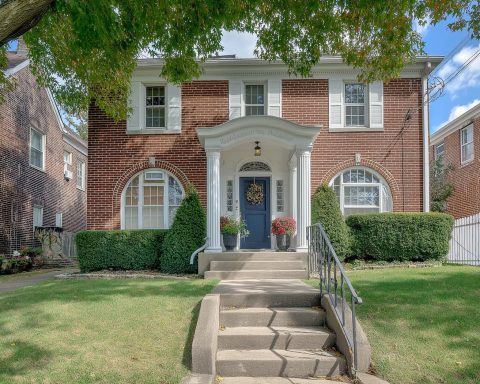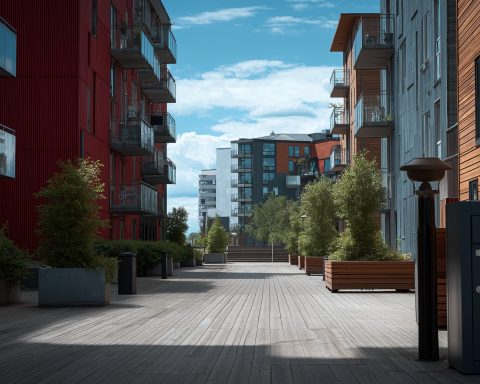- U.S. housing market flips to buyers’ favor: Home sellers across the United States are slashing prices and offering concessions as high mortgage rates and economic uncertainty sideline many buyers. Active home listings have surged ~25% year-on-year as unsold inventory piles up cpr.org, and 7 in 10 U.S. house-hunters are now priced out – the median listed price is ~$439,450 while a median-income buyer can only afford ~$298,000 cpr.org. “Even though we are seeing a substantial amount of price reductions, sometimes it’s not enough to move the home; it’s still sitting,” said one Denver agent of the market’s newfound stagnation cpr.org. The one silver lining: borrowing costs may finally ease soon – the Fed is expected to begin cutting interest rates at its Sept. 16–17 meeting, a shift that could gradually lower mortgage rates and revive demand reuters.com.
- Europe’s real estate in “zombieland”: Europe’s property sector remains in limbo, with commercial real estate deal-making near a decade low amid wary investors and reluctant sellers. Total investment in EMEA property collapsed ~20% year-on-year in Q2, the worst quarter in 10 years reuters.com. “We have ‘zombieland’… no recovery, stranded assets, no liquidity coming back,” quipped the European real estate head at PGIM, describing frozen markets for out-of-favor offices and malls reuters.com. Stretched affordability is also chilling housing: in the UK, for example, house prices dipped 0.1% in August, the third monthly fall since April, as buyers struggle with 6–7% mortgage rates reuters.com reuters.com. “Affordability remains stretched relative to long-term norms,” noted Nationwide’s chief economist, pointing out that a first-time buyer’s mortgage now eats ~35% of take-home pay (vs ~30% historically) reuters.com. Europe’s central banks have started gentle easing – the Bank of England trimmed rates to 4.00% last month – but warned that inflation risks could slow further rate cuts, keeping real estate under pressure reuters.com.
- China’s property crisis grinds on: China’s housing market remains fragile, with only modest effects from piecemeal stimulus. A new Reuters poll predicts new-home prices will fall ~3.8% in 2025, not as steep as feared (previous forecast -4.8%), but extending a multi-year downturn reuters.com. Sales and investment are set to drop further despite measures like lower down-payments, mortgage rate cuts, and state-backed programs to absorb unsold homes reuters.com. So far, these supports “have yet to yield significant improvements” as weak buyer sentiment persists amid high unemployment and a glut of vacant units reuters.com reuters.com. “Fitch believes the property sector will continue to face many structural challenges… including demographic shifts, low housing affordability and high unsold inventory,” warned Lulu Shi of Fitch Ratings reuters.com. Big developers remain distressed – Country Garden, once China’s largest builder, defaulted on $11 billion in debt and delivered only 74,000 homes in H1 2025 (half last year’s pace) amid its restructuring reuters.com reuters.com. Analysts say China’s housing slump may only bottom in 2026–27, and some call for more aggressive intervention (e.g. using fiscal funds to buy ~700 million m² of excess inventory for social housing) rather than incremental easing reuters.com reuters.com.
- Asia-Pacific outlook mixed: Australia’s housing market is rebounding as interest rates come down. The Reserve Bank of Australia has rolled back rates by 75 basis points since February, and mortgage analysts now forecast Australian home prices will rise about 5% in 2025, higher than earlier predictions reuters.com. “We’re expecting the lift in house prices to continue… As you get a few more rate cuts, household buying capacity will rise and put upward pressure on the housing market,” said Johnathan McMenamin of Barrenjoey, noting rate cuts have been fueling buyer demand reuters.com. However, stubborn affordability constraints will likely prevent another runaway boom – “house prices didn’t fall as much as anticipated [during the rate hikes], so they’re unlikely to increase as much… because affordability is already fairly stretched,” McMenamin added reuters.com. In Japan, where interest rates remain ultra-low, global investors are seeking opportunities: Germany’s PATRIZIA, for example, just acquired a portfolio of 14 Tokyo apartment buildings (~800 units) to expand in Japan’s solid rental market, expressing confidence in the stable demand there great.report. New Zealand and India are also seeing housing momentum – Kiwi home values are expected to edge up ~3–4% next year amid a post-slump recovery, and India’s high-end property segment is thriving (luxury demand could drive an ~8% price jump this year) even as mass-market affordability remains a challenge reuters.com.
- Middle East and emerging markets shine: Oil-rich markets continue to boom as global investors pivot toward more dynamic regions. Dubai’s real estate frenzy surged to new heights in August, with AED 51.1 billion (~$13.9 billion) in property sales – up 7.9% year-on-year – on a 15% jump in transactions great.report. “The figures reflect the consistent strength and resilience of Dubai’s market… drawing increasing international attention,” said Firas Al Msaddi, CEO of fäm Properties, as Dubai benefits from robust local and foreign buyer demand great.report. In Saudi Arabia, homeownership has hit 65.4% (as of end-2024), surpassing the kingdom’s 2025 target ahead of schedule, thanks to aggressive housing programs under Vision 2030 great.report. Elsewhere, African and Latin American real estate are seeing new investment. In Nigeria, for instance, domestic pension funds increased their real estate allocations by 418% in H1 2025 versus a year prior great.report – a massive shift bringing long-term local capital into the property sector. “These institutions have started to grow allocations… introducing previously absent long-term domestic capital into the real estate asset class,” explained Niyi Adeleye of Standard Bank on Africa’s burgeoning pool of homegrown investors great.report. Latin America is also drawing attention as a relative safe haven. With many of its stock markets (notably Brazil and Mexico) near record highs and offering attractive yields, global investors are underweight Latin America and now see opportunity in its stability reuters.com. That capital inflow – alongside cooling inflation – is expected to trickle into real assets as well. “The Latam story is easier to tell now… stocks are cheap and there is a lack of options in emerging markets,” noted Itau’s head of equities, pointing to Latin America’s appeal as other regions grapple with trade wars and slowing growth reuters.com reuters.com.
United States: Buyers Regain Leverage Amid Rate Pivot
After years of frenzied bidding wars, the U.S. housing market has dramatically cooled, tilting leverage back to buyers. Sky-high prices and 20+ year-high mortgage rates (hovering ~7%) have shrunk the buyer pool, forcing sellers to get realistic. Across many metros – especially in the South and West – listings are lingering and price cuts are now routine. U.S. active home listings have risen for 21 straight months, up ~25% from last summer, a stark reversal from the pandemic inventory crunch cpr.org. “It’s rare to see the type of eye-popping bidding wars [of a few years ago]… Low-ball offers are more common now,” reports the Associated Press cpr.org cpr.org. In fact, Realtor.com data shows 7 out of 10 median-income Americans can’t afford the median-priced home at current rates cpr.org.
The result? Sellers are cutting deals. Agents describe owners conceding on price, covering buyers’ closing costs, even helping buy down mortgage rates – unheard-of gestures in 2021’s seller’s market. “Even though we are seeing a substantial amount of price reductions, sometimes it’s not enough… [the home is] still sitting,” says Annie Foushee, a Denver-area Realtor, noting multiple rounds of markdowns are becoming common cpr.org. Nationally, the median listing price in July ticked up just ~1% annually (to $439k) – but that masked outright declines in overheated markets like Austin (-4.9% YoY), Miami (-4.7%), Los Angeles (-4.2%), and Denver (-4.0%) cpr.org.
Despite this housing slump, a broader shift is underway that could revive activity: interest rates may finally be coming down. After 18 months of monetary tightening, the Federal Reserve is widely expected to cut its benchmark rate by 0.25% next week, the first cut in a projected series reuters.com. Futures markets are pricing in at least three Fed rate reductions by January as U.S. inflation cools and job growth slows reuters.com. Mortgage costs have already eased slightly from their peak – the average 30-year fixed rate recently dipped to ~6.56%, a 10-month low great.report great.report – spurring a modest uptick in homebuyer interest. “Mortgage rates are at a 10-month low… purchase demand continues to rise on the back of lower rates and solid economic growth,” observed Sam Khater, Freddie Mac’s chief economist great.report great.report. Still, any housing rebound will be measured: affordability remains stretched (U.S. home prices are up ~57% since 2020, adding $20 trillion in value wapt.com), and credit is tighter after recent bank stresses.
The commercial real estate picture in the U.S. is even more sobering. Office landlords face a record vacancy rate above 20%, a “slow-motion crisis” fueled by remote work reuters.com. Moody’s Analytics data show national office vacancies hit 20.7% in Q2 2025 – the highest on record reuters.com. In tech hubs like San Francisco, a staggering 27.7% of office space now sits empty (vs. ~8.6% pre-pandemic) reuters.com. Even New York’s iconic business districts are grappling with 20%+ vacancy reuters.com. This glut of empty offices is hammering property values and straining regional banks, many of which hold piles of commercial mortgages. Landlords facing debt maturities can’t refinance without significant equity infusions, leading to defaults and “extend-and-pretend” tactics to avoid fire sales reuters.com reuters.com. City governments are feeling the pinch too as building tax revenues erode, threatening public services reuters.com.
To adapt, the industry is pivoting away from offices. Developers are exploring conversions of obsolete towers into apartments or other uses – over 149 million square feet of U.S. office space is now earmarked for potential conversion projects reuters.com. There’s also a flight to quality: tenants that are leasing tend to choose top-tier, amenity-rich buildings, leaving older Class B/C properties in a tailspin reuters.com. Meanwhile, investment capital is shifting into segments with better fundamentals, like industrial warehouses, data centers, and multifamily rentals, which have fared relatively well. As one report summed up, “the office market has reached a breaking point,” forcing a re-imagining of urban real estate for the post-COVID era instagram.com reuters.com. Some optimistic investors are bottom-fishing distressed office assets, but most are biding time until prices reset further.
Amid these challenges, big players are pouncing on strategic deals. The past week saw major consolidation moves: Apollo Global Management closed a $1.5 billion buyout of Bridge Investment Group (doubling Apollo’s real estate assets under management to $110 billion) and BlackRock acquired net-lease firm ElmTree Funds, adding $7+ billion to its portfolio great.report great.report. Together these deals put $57 billion in property assets under new ownership – a sign that well-capitalized institutions view today’s turmoil as a buying opportunity great.report great.report. “Perceived market dislocation is leading to more consolidation,” notes Bisnow, as giants like Apollo and BlackRock seek scale great.report. The rental market also remains a magnet for investors: by mid-2025, investors made nearly 30% of U.S. home purchases, up from historical ~20–25% levels great.report. Large landlords and private equity buyers are snapping up homes to convert into rentals, betting that high costs will keep many Americans renting. “Investors expanded their market presence significantly in 2025… Their resilience in a high-price, high-rate environment positions them to meet rental demand,” said Thom Malone, a real estate principal, on the growing role of institutional buyers great.report.
In short, the U.S. real estate landscape is bifurcated: residential markets are bottoming out as rate relief appears on the horizon, while commercial markets (especially offices) confront a harsh new reality. The coming rate cuts may bolster housing somewhat – though likely “only modestly, with affordability pressures already at breaking point”, as JLL’s Matt McAuley cautions reuters.com. And in commercial real estate, a true recovery might require creative reinvention (and a lot of patience from lenders) to overcome the pandemic’s lasting scars.
Europe: Stalled Markets, Squeezed Buyers
Europe’s real estate sector is stuck in a rut as high borrowing costs and economic jitters reverberate through both commercial and residential markets. Earlier hopes that 2025 would bring a turnaround have largely fizzled. Instead, transaction volumes have plummeted – many deals are on ice as buyers and sellers remain far apart on price. Knight Frank reports European property sales totaled just €17.2 billion in Q2, down about 20% from a year ago and marking the slowest spring quarter in a decade reuters.com. Would-be buyers are shunning especially any asset linked to discretionary spending or outdated formats. Hardest hit are office buildings (especially older, energy-inefficient ones) and secondary retail properties like aging malls reuters.com. Even data centers, a recent darling, have seen interest cool reuters.com. “In some parts of the market the recovery is well under way… However there are out-of-favour assets and sectors where there is almost no liquidity and more pain to come,” observed Cecile Retaureau of Phoenix Group’s investment arm, contrasting pockets of resilience with broad malaise reuters.com.
The mood was summed up bluntly by Sebastiano Ferrante of PGIM: “We have ‘zombieland’… no recovery, stranded assets, no liquidity coming back.” reuters.com In other words, Europe’s commercial real estate is neither collapsing outright nor truly recovering – just frozen. Lenders and landlords are often extending loans and deferring reckoning (“extend and pretend”), hoping conditions improve before they must mark down values. But cracks are showing: distress is emerging in key markets. In Germany, property deal volumes fell another 2% in H1 (on top of a dismal 2024), and now some marquee assets are being forced to market. Reuters reports Frankfurt’s Trianon skyscraper – a 45-story tower whose owner went insolvent – is up for sale by its administrator, a high-profile test of investor appetite in Europe’s largest economy reuters.com. London’s Citypoint tower saw its owner Brookfield seek to restructure the debt after shelving a sale that drew lowball bids reuters.com. These examples underscore steep drops in values – buyers today won’t pay yesterday’s prices, and many sellers (or their bankers) are reluctantly coming to terms with that.
One relative bright spot is logistics and “beds” – sectors like warehouses, rental housing, and hotels still have buyers. Europe’s undersupplied rental housing market continues to attract interest reuters.com, as chronic housing shortages in many cities mean stable occupancy and rents. Even so, soaring interest rates have made financing any real estate deal costlier. The European Central Bank’s rapid-fire rate hikes (to combat inflation) lifted costs across the Eurozone; now at least the cycle has peaked. The ECB paused further hikes after its last increase to 4.25%, and the Bank of England actually cut rates from 4.25% to 4.00% in August, becoming one of the first major Western central banks to ease reuters.com. This monetary pivot is expected to gradually thaw real estate markets – lower rates should improve financing and “provide a small boost to the housing market… setting a firm floor under future price falls,” as Aneisha Beveridge of Hamptons observed for the UK reuters.com reuters.com. But so far the impact is limited; lenders remain cautious and investors have alternative places (like private credit funds) to deploy cash reuters.com. In H1 2025, European private credit funds raised nearly $40 billion, almost double the capital raised by real estate funds reuters.com – meaning many investors are betting on debt or other assets rather than buying properties outright.
On the residential side, Europe presents a mixed picture. Several countries saw home prices soften in 2023–2024 after the post-COVID boom, but there’s considerable variation:
- United Kingdom: After years of rapid growth, UK home prices have essentially flatlined in 2025, with some modest declines recently. Nationwide’s index unexpectedly showed a 0.1% drop in August (the first monthly dip since April) reuters.com. Annual house price growth is running just ~2% – the weakest in over a decade reuters.com. Stretched affordability is largely to blame: even though prices have paused, borrowing costs near 15-year highs have shrunk buyers’ budgets dramatically. “The relatively subdued pace of house price growth is understandable, given that affordability remains stretched relative to long-term norms,” explained Nationwide’s Robert Gardner reuters.com. Indeed, British first-time buyers’ mortgage payments now average ~35% of take-home pay, vs ~30% historically reuters.com. The Bank of England’s tentative rate cuts should gradually ease that burden – UK mortgage rates have dipped from their 2023 peak – but real incomes are only just starting to outpace inflation, so homebuyer confidence is still fragile. One hopeful sign: wages are rising ~7% while inflation is trending toward ~4–5%, improving real pay reuters.com reuters.com. A Reuters poll of analysts expects UK home prices to rise ~3% in 2025 as borrowing costs fall further and affordability slowly improves reuters.com reuters.com. London’s prime market, buoyed by foreign demand and safe-haven appeal, is forecast to see smaller gains (~1.8% in 2024, ~3.2% in 2025) reuters.com. For now, however, Britain’s housing market is in a standoff – buyers are hesitant, sellers are finally tempering expectations, and rents are surging (~6% expected this year reuters.com) as frustrated would-be buyers stay in the rental market.
- Germany: Europe’s largest economy is navigating a sharp housing cooldown. German house prices plunged about 7% in 2024, the steepest drop on record reuters.com, and 2025 is likely to see only a tepid rebound if any. A combination of factors hit Germany particularly hard: strict lending regulations, a surge in construction costs, and an end to ultra-cheap financing revealed overvaluations in many markets. Developers have slammed the brakes – residential building permits have fallen, and some projects were halted as financing dried up. On the flip side, rents in major German cities are climbing, as a supply-demand imbalance persists (a problem amplified by an influx of refugees and migrants adding to housing demand). The German government has debated incentives to spur construction and even easing energy efficiency rules to lower costs for developers. But until interest rates come down, housing activity is expected to stay muted. The ECB’s pause is a relief, yet borrowing costs remain far above 2021 levels. A recent Reuters poll predicted German home prices will rise only ~3% in 2025, trailing general inflation, before picking up a bit more in 2026 reuters.com. “It will not kickstart in a very dynamic way,” said Konstantin Kortmann, CEO of JLL Germany, who anticipates a very gradual recovery in transactions reuters.com.
- France, Spain & others: Most other European markets have cooled but avoided severe corrections. France has seen prices plateau, with Paris still extremely expensive (and rents now capped by law to improve affordability). Spain and Portugal experienced an influx of foreign buyers (and digital nomads) during the pandemic, which propped up prices; those markets are now leveling off as interest rates rise and some expats depart. Italy remains bifurcated – Milan is hot, but many rural/small-town areas languish. Nordic countries (like Sweden) had more pronounced downturns in 2022–23 due to high household debt and variable-rate mortgages; they too are stabilizing as rate hikes pause. For example, Sweden’s housing prices fell ~10–15% from peak, and several big landlords nearly defaulted under higher rates, but emergency measures and a likely Riksbank rate cut by early 2026 have calmed fears. Overall, Europe’s housing markets are poised for a slow climb back – helped by scarce supply (a long-standing issue in many cities) and the expectation of rate relief, but capped by stricter lending and cautious sentiment after the rollercoaster of recent years.
In sum, Europe’s real estate is in a holding pattern. Buyers and investors are waiting for clearer signals – either bigger price discounts or a definite turn in the rate cycle. Governments are under pressure to stimulate housing construction (to tackle affordability) without re-inflating bubbles. As one analyst put it, “Transaction volumes will not jump” overnight reuters.com. Instead, the continent faces a grind-it-out recovery, where prime assets in prime locations recover first (and continue to lure capital from abroad, given Europe’s relative geopolitical stability), while older and peripheral assets struggle to find a bid. The divergence is clear: a brand-new, energy-efficient office in, say, Paris or Berlin might still fetch interest, whereas a tired suburban office park or secondary shopping center could remain a “stranded asset” for some time reuters.com. 2025’s second half will test whether Europe’s tentative rate cuts can breathe life into this “zombieland” or if more drastic measures (such as bank-led restructuring sales or government interventions) will be needed to jump-start the market.
China: Crisis Continues, Hopes and Fears Persist
China’s real estate meltdown remains the central risk in its economy, even as authorities unleash support measures to stem the slide. In the past 48 hours, new data and analyst forecasts underscore a sobering outlook: home prices are still falling in many cities, sales are scraping along multi-year lows, and developers are mired in debt. Yet there are glimmers that the worst may (slowly) be passing, provided Beijing steps up with more forceful action.
A Reuters poll of economists (conducted Aug. 26–Sept. 3) forecasts China’s new-home prices will drop 3.8% in 2025, year-on-year reuters.com. While that is a significant decline, it’s less severe than the 4.8% fall predicted a few months ago, thanks to recent policy moves reuters.com. Beijing has clearly shifted to propping up housing demand: in the past few weeks, minimum down payments were slashed (to 20% for first homes, 30% for second homes in many cities), mortgage rates were cut (some first-home rates below 5-year highs), and purchase restrictions were eased in big cities like Guangzhou and Shenzhen reuters.com. Local governments and banks are also rolling out programs to dispose of unsold housing stock – for instance, by buying empty apartments to convert into public rental units reuters.com. These steps have led to a minor uptick in inquiries and transactions in top-tier cities. In Beijing and Shanghai, media report improved buyer traffic at project showrooms after mortgage rules relaxed. Some developers have even marketed that “homes sold overnight” after policy changes (though such claims are likely overstated) visiontimes.com.
Despite these efforts, China’s property market is far from stabilized. The Reuters poll found analysts widely split – some think prices could plunge as much as 15%, others see almost flat – reflecting uncertainty about whether Beijing will truly rescue the sector reuters.com. Property sales and investment are forecast to keep contracting in 2025, by 7.5% and 11% respectively, even worse than expectations from earlier this year reuters.com. The fundamental issues are deep: developers are overleveraged, many homebuyers have lost confidence (after seeing unfinished “rotting” projects and slumping values), and China’s demographics are turning (fewer young families to buy homes). “Weak income expectations, elevated unemployment… and high listings in the secondary market continue to dampen buyer sentiment, particularly in smaller cities,” the Reuters analysis noted reuters.com. Essentially, beyond the biggest metros, China has an oversupply of housing – by one estimate, 600–700 million square meters of unsold homes need to be absorbed to normalize the market reuters.com.
The developer crisis continues to unfold in real time. Country Garden, once China’s #1 homebuilder, is emblematic of the sector’s woes. After defaulting on $11 billion of offshore bonds in late 2023 reuters.com, Country Garden has been scrambling through a $14 billion debt restructuring. Just weeks ago, it warned it will post a huge loss (up to ¥21.5 billion, ~$2.6 billion) for the first half of 2025 reuters.com. The firm’s housing project deliveries plunged by 50% (only ~74,000 units in H1 vs 150,000 a year prior) reuters.com, as liquidity dried up and construction slowed. It did secure a deal with some creditors to extend debt reuters.com, buying time. Meanwhile Evergrande Group, whose 2021 default sparked the crisis, remains under restructuring with uncertainties around its offshore assets. A slew of smaller developers have also defaulted or are on the brink, leading to scores of unfinished developments across China. This has eroded the presumption that “real estate only goes up” – a belief that fueled China’s housing boom for decades.
Analysts are increasingly urging bolder action to break the vicious cycle. Some propose direct government intervention: for example, state agencies or policy banks purchasing unsold housing inventory and land, thus providing developers cash and reducing oversupply reuters.com. “To bring the destocking cycle back to a healthy 12-month level… roughly 600–700 million m² of unsold inventory must be absorbed… requiring about ¥5 trillion ($700 billion),” calculates Gao Yuhong of Pengyuan Credit Rating, suggesting public funds be deployed in such a program reuters.com. Others argue for relaxing the “three red lines” (the leverage limits on developers) to let healthier firms borrow again, or guaranteeing completion of pre-sold homes to restore buyer trust. Thus far, Beijing’s approach has been incremental – easing some rules here, nudging banks to lower lending rates there – reluctant to signal an all-out bailout. The fear may be moral hazard and replay of past excesses. But with real estate accounting for 1/4 of China’s GDP by some measures, a prolonged slump risks derailing the broader economy (already, GDP growth is struggling to reach 5% this year).
“Fitch believes the property sector will continue to face many structural challenges in the medium term, including demographic shifts, low housing affordability and high unsold inventory,” warned Lulu Shi, a director at Fitch Ratings reuters.com. Indeed, China’s population is now shrinking, and urbanization is slowing, meaning the era of ever-expanding housing demand is likely over. Younger Chinese are also less eager (or able) to buy, given precarious jobs and falling marriage rates. Housing affordability in big cities remains very low – in places like Shenzhen or Beijing, home price-to-income ratios above 30× are common, putting ownership out of reach for most without family help.
That said, China’s government still has powerful tools to engineer a turnaround if it chooses. The central bank (PBoC) can further cut benchmark rates (it cut mortgage reference rates in Q3). The government could ease up on local purchase restrictions nationwide (some cities still bar buying multiple homes or impose residency requirements). There’s also talk of removing the pre-sale system entirely (whereby buyers pay upfront for units delivered later) to rebuild trust – recent reports suggest China may “ban pre-sales and require completed homes” for sale going forward thestandard.com.hk, a radical shift that would reshape developer financing. Any such reform would need transitional support to not bankrupt developers mid-way.
For now, the consensus is that China’s real estate funk will drag into 2024–2025. Most analysts in the poll don’t see home prices nationwide bottoming until late 2026 or 2027 reuters.com. The path to recovery is slow and uneven: top-tier cities will stabilize first (some are already seeing slight price upticks month-on-month), whereas smaller cities with big gluts may take years to work through inventory. The government’s stance is cautiously shifting from crackdown to support, but it’s a delicate balance – they want to stimulate housing enough to boost the economy, but not reignite speculative frenzy or ballooning debt. Globally, China’s property slump has dampened demand for commodities like iron ore and hurt foreign businesses (e.g. construction machinery sales). However, there’s an argument that a stabilized (if smaller) Chinese real estate sector is healthier long-term than the debt-fueled bubble it was.
Bottom line: China’s real estate is “too big to fail” – and Beijing is signaling it won’t let it fail, but also “too big to bail” easily – any fix is costly and complex. The coming months will reveal whether incremental measures can stop the bleeding, or if a more dramatic rescue (and its massive price tag) will be necessary to restore confidence in what was once the world’s hottest property market.
Asia-Pacific & Oceania: Resilience in the Pacific Rim
Beyond China, other major Asia-Pacific property markets present a contrast – some are rebounding thanks to policy tailwinds, while others are coping with the aftermath of rate hikes.
Australia stands out as a case where the tide is turning positive. After a brief dip in 2022, Australian house prices are climbing again in 2023–2025. The engine: interest rate relief and chronic undersupply. The Reserve Bank of Australia (RBA) aggressively raised rates through late 2024 (peaking at 4.35%) but has since made a dovish pivot, cutting the cash rate by a cumulative 0.75% in 2025 reuters.com. Borrowers are finally exhaling as mortgage rates come down a bit. According to a new Reuters poll, analysts now expect Aussie home values to rise about 5% in 2025, up from a 4% forecast previously reuters.com. “We’re expecting the lift in house prices to continue… [As] the RBA delivered its second rate cut, [it] really has been picking up [the market],” said Johnathan McMenamin, head of economic forecasts at Barrenjoey, noting that each rate drop boosts buyers’ purchasing power reuters.com. Major cities like Sydney and Brisbane are leading the upswing, with prices already 4–7% higher year-to-date reuters.com. By year-end, national prices are on track to surpass their pre-pandemic peak – a rapid rebound after a modest correction.
However, experts caution this won’t be an unchecked boom. Australian housing is already among the world’s most expensive (median prices ~8× average income) reuters.com, and affordability remains severely stretched for first-home buyers. “Because house prices didn’t fall as much as we anticipated during the [rate-hike] cycle, they’re unlikely to increase as much [during the cutting cycle]… affordability is already fairly stretched,” McMenamin explained reuters.com. In other words, the upside from rate cuts may be limited by borrowers’ income constraints and banks’ lending standards. Additionally, supply constraints persist: construction of new homes in Australia has lagged population growth (especially with immigration resuming). With rental vacancy rates under 1% in some cities, rents are soaring, which ironically supports investor demand for homes even as it hurts renters. The RBA is expected to cut a bit further – markets see a terminal rate around 3.1% by early 2026 (from 3.6% now) reuters.com – which should underpin modest price growth into 2026. Notably, New Zealand is following a similar trajectory: after a ~17% price crash from late 2021 to 2023, Kiwi home prices are bottoming out and forecast to rise ~3–4% in 2025 as the Reserve Bank of New Zealand signals rate cuts reuters.com reuters.com.
Japan continues to be a unique real estate environment. Ultra-low interest rates (the Bank of Japan still has a negative policy rate) make mortgages very cheap, and that has propped up housing values, especially in Tokyo and other major metros. Japanese home prices have been gently rising in recent years – a far cry from the 1980s bubble, but a steady upward trend as people favor modern earthquake-resistant and energy-efficient builds. Condo prices in Tokyo hit record highs in 2023 and remain elevated. The BOJ has begun tinkering with its yield-curve control, allowing long-term rates to inch up, but thus far there’s been no shock to housing. On the commercial side, Japan is benefiting from its safe-haven status: global investors priced out of the West (or wary of China) are increasing allocations to Japanese real estate. This week saw Germany’s PATRIZIA acquire 14 apartment buildings in Tokyo (~800 units) as a long-term investment great.report. “This acquisition… reflects our confidence in Tokyo’s residential market,” said Masami Takizawa, PATRIZIA’s Japan head great.report. They’re attracted by Japan’s stable rents, high occupancy, and the prospects of an eventual yield uptick if Japan normalizes rates. Similarly, Singaporean and other Asian funds have been snapping up logistics facilities and data centers in Japan. One concern is Japan’s population decline, which means some regional markets will struggle, but in the big cities, urban migration and redevelopment keep demand healthy.
India is another bright spot worth mentioning. While not traditionally seen as a transparent market, India’s real estate sector has been booming in segments. The luxury residential segment, in particular, is red-hot – Reuters noted that demand from cash-rich Indians is driving prices of high-end properties up ~8% this year, and another ~6% next year reuters.com. This is a country where tens of millions are entering the middle class, and there’s a cultural preference for owning homes. Developers focused on mid-tier and affordable housing face some headwinds (rising construction costs, higher mortgage rates earlier this year), but the long-term outlook is robust thanks to urbanization and government initiatives (like the Smart Cities mission). There are also structural reforms like RERA (a real estate regulation law) that have improved buyer confidence in recent years. Foreign investment in Indian real estate is growing too – for example, global private equity has been active in India’s office and warehousing sectors, betting on the IT industry and e-commerce growth.
Other Asia-Pacific markets are generally in better shape than China:
- Southeast Asia: Countries like Indonesia, Malaysia, and Vietnam have young populations and rising housing demand. They didn’t see huge property bubbles recently, so their markets are on moderate growth trajectories. Singapore is an outlier – its property market soared during COVID (wealth inflows, low rates) leading the government to impose cooling measures and higher stamp duties on foreigners. Those measures have tempered sales; prices in Singapore are now leveling off after a ~25% surge over 2020–2023. Vietnam had a speculative condo boom that cooled as authorities cracked down on corruption and tightened credit in 2022; now, with inflation low, Vietnam’s central bank has cut rates multiple times in 2023–2024, hoping to reignite real estate and construction.
- Hong Kong: After years of stratospheric prices, Hong Kong’s housing market has been in a correction, down roughly 15% from its peak in 2021. Interest rates there track U.S. Fed rates (due to the HKD peg), so the high rates hit HK’s property hard. The luxury segment in Hong Kong, sensitive to mainland Chinese buyer sentiment, has also softened. 2025 might bring some stabilization if the Fed cuts and China’s economy picks up, but for now, HK property is at its weakest in years, with home prices hovering near 5-year lows.
- South Korea: Housing in Seoul saw a big run-up through 2021, followed by a roughly 10% price dip. The government, which had implemented anti-speculation taxes, started rolling some back as the market cooled. Now, with the Bank of Korea likely done with hikes (and potentially eyeing cuts in 2024), Seoul’s housing market is perking up again. Transactions rose this summer and prices ticked up modestly, leading authorities to monitor for renewed froth.
Overall, the Asia-Pacific real estate scene is defined by diverging fortunes. Export-reliant economies like South Korea and New Zealand had to tighten policy hard and saw property corrections, but are poised for a gentle recovery as rates ease. Domestic-driven economies like India and Indonesia continue to see structural growth in real estate demand. Australia and New Zealand demonstrate how quickly sentiment can turn when central banks shift from hikes to cuts. And Japan remains steady Eddie, a preferred destination for international capital escaping volatility elsewhere.
One more theme: Global investors are actively reallocating within APAC. Money that might have gone to China is being redirected to places like Japan, Singapore, and India. Australian commercial real estate – particularly logistics and rental housing – is also attracting overseas investors given Australia’s strong immigration and rule of law. For instance, warehousing in Australia is in high demand due to a supply-chain rethink post-COVID (more inventory kept onshore), driving record low industrial vacancies and development booms in Sydney/Melbourne outer suburbs.
In summary, Asia-Pacific real estate is weathering the global rate storm with relative resilience, aside from the unique situation in China. Many markets are already looking forward to 2025 as a year of renewed growth, provided inflation stays under control and those much-anticipated rate cuts materialize. The region’s solid demographics and economic growth prospects make it a key focus for property investors rotating out of troubled Western markets – a dynamic that should continue to support APAC property values.
Middle East & Africa: Boom Times and New Frontiers
While Western real estate languishes, the Middle East is enjoying a property boom driven by high oil revenues, economic reforms, and an influx of foreign wealth. Gulf Arab nations in particular are experiencing a real estate renaissance, with governments actively promoting development as part of their diversification strategies.
Dubai, UAE, is a prime example. The city famous for its skyscrapers and luxury villas is breaking sales records in 2025. August saw AED 51.1 billion (≈$14 billion) in real estate transactions, a 7.9% jump from last year and one of the highest monthly totals ever great.report. Volumes are surging – 15% more property deals happened than the same month a year prior great.report. This isn’t just high-end homes for foreign billionaires (though those are selling too); it spans apartments, townhouses, and commercial units. Local end-user demand and international investor interest are both strong, attracted by Dubai’s relative stability and zero income-tax status. “The figures reflect the consistent strength and resilience of Dubai’s market… drawing increasing international attention,” said Firas Al Msaddi, CEO of a top Dubai brokerage great.report. Indeed, Russians, Europeans, Chinese and others have poured money into Dubai real estate as a safe haven amid global turmoil. Prices have been climbing – up ~20% year-on-year in some villa communities – and developers are racing to launch new projects. The government is mindful of not letting a speculative bubble form (Dubai had a boom-bust in 2009), but so far the growth seems underpinned by genuine demand and population inflows. Dubai’s population crossed 3.6 million and is growing fast, fueling record housing rents (up ~25% YoY), which in turn entice investors seeking yield.
Abu Dhabi, Qatar, and Saudi Arabia are also seeing vibrant real estate activity. Saudi Arabia in particular has made housing a pillar of its Vision 2030 reforms. The Kingdom’s efforts to boost homeownership (affordable mortgage schemes, massive new suburban developments) have borne fruit: the homeownership rate hit 65.4% by end-2024, exceeding the official 2025 target great.report. That’s up from about 50% a decade ago – a remarkable rise credited to subsidized home loans and programs encouraging first-time buyers. Saudi Arabia is also undertaking giga-projects like NEOM (a futuristic $500 billion city) and The Line, which, while far from completion, are spurring real estate and construction sector growth. Riyadh’s plan to become a global business hub has led to a construction boom for offices and hotels there, and foreign investor rules have been loosened to allow 100% ownership of properties in certain zones.
Across the Middle East, wealth from energy exports (oil at ~$85/barrel) is translating into real estate investment. Qatar saw a post-World Cup development surge, Bahrain and Oman are liberalizing property laws to attract expats, and Egypt (though not in the Gulf) is building a whole new administrative capital city from scratch.
Turning to Africa, the narrative is about emerging domestic investment and some foreign interest in key cities. Historically, African real estate relied heavily on foreign capital or government spending, but now local institutional investors are stepping up. A standout example: Nigeria’s pension funds dramatically increased allocations to real estate in the past year, by 418% in H1 2025 vs H1 2024 great.report. Nigeria has huge pension assets (over ₦15 trillion, ~$20 billion) that were previously mostly in bonds. Regulatory changes and the need for diversified returns have these funds eyeing property – both development projects and income properties. “These institutions have started to grow allocations… introducing previously absent long-term domestic capital into the real estate asset class,” explained Niyi Adeleye, Head of Real Estate for Africa at Standard Bank great.report. This trend is crucial: homegrown capital can sustain real estate growth even when foreign investors pull back. It’s not just Nigeria; Kenya’s pension funds are also upping real estate exposure, and South Africa has long had significant local investment in property through REITs and banks (though SA’s economy is currently stagnant, limiting new development).
On the continent’s ground level, housing demand is soaring due to urbanization, but supply lags painfully. Affordable housing is a huge challenge in cities like Lagos, Nairobi, Cairo – creating opportunities for investment but also social pressures. Some governments are partnering with the private sector on mass housing (e.g., Kenya’s affordable homes program, Nigeria’s social housing plan), but financing and infrastructure constraints abound. Still, there are bright spots: Egypt has built vast new suburbs around Cairo; Rwanda’s Kigali is planning green, master-planned communities; Ghana is streamlining land titling to encourage development.
South Africa, the continent’s most developed real estate market, is facing high interest rates (the South African Reserve Bank’s rate is 8.25%) and economic woes, which have cooled its housing market. Commercial property in Johannesburg and Cape Town is stable but not growing much, and the office sector has high vacancy (similar to global trends).
In North Africa, countries like Morocco and Tunisia have seen housing softness amidst economic troubles, though Morocco’s luxury market in Marrakesh got a lift from foreign buyers recently (until a tragic earthquake in Sept 2023 dealt a blow).
Sub-Saharan Africa is also seeing some foreign investment in niche sectors: for instance, data centers (driven by tech growth), logistics facilities (as e-commerce expands), and city-building projects like the new city of Diamniadio in Senegal or Eko Atlantic in Lagos. These projects show the ambition to modernize African cities, though their success varies.
Meanwhile, Latin America is emerging as a surprise winner in the global capital rotation. As noted, investors worldwide are increasing exposure to LatAm as they diversify away from the U.S. and China. Real estate in Latin America stands to benefit indirectly from this trend – a stronger macro environment and investment inflows tend to boost demand for offices, warehouses, and housing.
Brazil, the region’s largest economy, has seen a relatively resilient property market. After the central bank’s aggressive rate hikes (which peaked the Selic rate at 13.75% in 2022–23), inflation has come down to around 5% great.report, allowing Brazil’s central bank to start cutting rates this year. Lower interest is positive for Brazil’s mortgage market and homebuilders. Indeed, Brazilian homebuilders’ stock prices have rallied in anticipation of easier credit. Brazil also has a unique growth area in agri-land and logistics – as a commodities powerhouse, farmland values are up, and there’s massive demand for warehouses due to e-commerce and for grain storage upcountry. International investors like Blackstone and Prologis have put money into Brazilian industrial real estate for the long term.
Mexico is another hotspot, partly due to “nearshoring.” With U.S.–China tensions, many U.S. companies are shifting supply chains to Mexico, driving record industrial real estate demand in Mexican border cities and industrial hubs. Vacancy in prime industrial parks in Monterrey, Tijuana, etc., is near zero, and rents are climbing. This industrial boom is spilling over to housing – cities like Monterrey and Guadalajara are seeing housing upticks as jobs grow. Mexico’s housing market overall is stable; it didn’t overinflate in the 2020s, and mortgage rates are high but the banking system is solid.
Smaller LatAm countries have varied situations: Colombia and Peru have had slower economies recently which cooled real estate, while Chile is relatively stable/institutionalized in its property sector. Argentina is a wild card – with inflation over 100%, its real estate market operates heavily in cash and dollars; there’s interest from some brave foreign investors hoping for an eventual rebound if Argentina’s elections bring reform.
Crucially, Latin America’s appeal to investors is that assets are comparatively cheap. As Reuters noted, “stocks are cheap and there is a lack of options in emerging markets”, making LatAm intriguing reuters.com. The same could be said for real estate: prime office rents in São Paulo or Mexico City are a fraction of those in New York or London, yet vacancy is not high and economies are growing. That value proposition, combined with LatAm’s demographic advantages (young populations), suggests long-term growth potential. We are seeing early signs: just as African pensions pivot to property, Latin American institutional investors (like Chile’s and Peru’s pension funds, or Mexican insurance firms) are also allocating more to real estate in search of yield. International players, too, are active – for example, Canada’s Brookfield has been investing in Brazilian real estate, and U.S. and European funds have snapped up logistics assets across LatAm.
In summary, emerging markets show that real estate fortunes are not universally dour in 2025. The Middle East is booming on strong fundamentals and capital inflows, Africa is starting to mobilize its own capital for development, and Latin America is benefiting from a reordering of global investment flows. Of course, these regions are not without risks – geopolitical stability and currency fluctuations can quickly change the outlook. But for now, they represent pockets of strength that stand in counterpoint to the woes in the U.S., Europe, and China. As one expert noted about London becoming a safe haven “given a world on fire” reuters.com reuters.com, the same logic is pushing investors to consider Dubai, São Paulo, Mexico City, or Nairobi – locations they might have once overlooked – in the quest for growth and returns in real estate.
Sources:
- Associated Press – “Shortage of homebuyers forces many sellers to lower prices…”, Sep 9, 2025 cpr.org cpr.org
- Reuters – U.S. Fed policy outlook (rate cuts expected) reuters.com
- Reuters – “European real estate stuck in ‘zombieland’…”, Jul 17, 2025 reuters.com reuters.com
- Reuters – UK Nationwide house price data, Sep 1, 2025 reuters.com reuters.com
- Reuters – Global Housing Market Poll (Aug–Sep 2025) reuters.com reuters.com
- Reuters – “China’s home prices to fall less than expected, market still weak”, Sep 4, 2025 reuters.com reuters.com
- Reuters – Country Garden financial update, Aug 22, 2025 reuters.com reuters.com
- Reuters – “Aussie home prices to rise on rate cuts, affordability worries”, Sep 10, 2025 reuters.com reuters.com
- Great.Report – Global Real Estate Roundup (Sept 3–4, 2025) great.report great.report
- Reuters – “Investors eye Latin America as they diversify away from Wall Street”, Jun 9, 2025 reuters.com reuters.com












